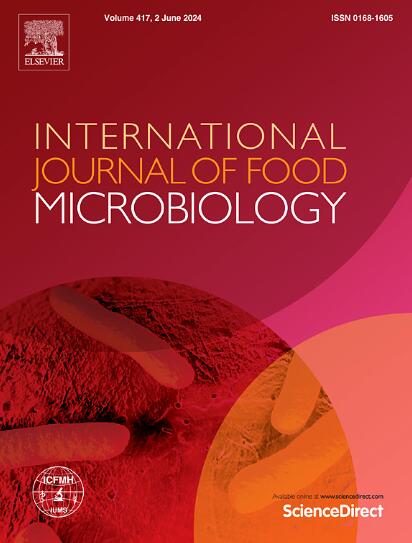Rapid and quantitative detection of Botryosphaeria dothidea by surface-enhanced Raman spectroscopy with size-controlled spherical metal nanoparticles combined with machine learning
IF 5.2
1区 农林科学
Q1 FOOD SCIENCE & TECHNOLOGY
International journal of food microbiology
Pub Date : 2025-05-30
DOI:10.1016/j.ijfoodmicro.2025.111288
引用次数: 0
Abstract
Botryosphaeria dothidea infection has become a major factor affecting the quality of postharvest fruits, so detection of B. dothidea infection is very important to control the spread of infection and ensure food safety. In this study, we built a monitoring platform for rapid and quantitative detection of B. dothidea by Surface-enhanced Raman spectroscopy (SERS) with size-controlled spherical metal nanoparticles combined with machine learning, and the platform could also detect a variety of pathogens. With spherical metal nanoparticles as the active substrate, the SERS enhanced effect was significantly size-dependent. 45–60 nm Ag@ICNPs was determined to achieve the maximum SERS signal detection of B. dothidea, and used as the active substrate to construct a SERS platform for rapid and quantitative detection of B. dothidea. This platform had potential practicability in actual sample detection. The platform was used for the detection of Pseudomonas syringae pv. Actinidiae, Pseudomonas aeruginosa, Ralstonia solanacearum and Pseudomonas extremorientalis, and the SERS fingerprint information of these pathogens was successfully captured, and the quantitative analysis ability of these pathogens was also strong. Machine learning analysis was performed on the SERS spectra of pathogens obtained. Based on the differences between the spectral data sets of different pathogens, PCA could effectively distinguish these five pathogens into different groups. The accuracy rates of SVM, Tree, Linear discrimination analysis, Efficient logistic regression, Naive Bayes, K-Nearest Neighbors, Ensemble and Neural network test were 100 %, 96 %, 100 %, 100 %, 100 %, 100 %, 98 % and 100 % respectively, all of which had relatively high accuracy rates. Overall, this study provides a simple, efficient and accurate method for rapid quantitative detection and identification of multiple pathogens, and can be extended to practical agricultural products.
尺寸控制球形金属纳米颗粒结合机器学习的表面增强拉曼光谱快速定量检测斑点球孢菌
牛弧菌感染已成为影响采后水果品质的主要因素,因此检测牛弧菌感染对控制感染传播,保证食品安全具有重要意义。在本研究中,我们利用球形金属纳米颗粒结合机器学习,构建了表面增强拉曼光谱(SERS)快速定量检测dothidea的监测平台,该平台也可以检测多种病原体。以球形金属纳米颗粒作为活性底物,SERS增强效果具有明显的尺寸依赖性。确定45 ~ 60 nm Ag@ICNPs为最大SERS信号检测范围,并作为活性底物构建快速定量检测白颊白蝇的SERS平台。该平台在实际样品检测中具有潜在的实用性。该平台用于丁香假单胞菌pv的检测。成功捕获了猕猴桃菌、铜绿假单胞菌、茄枯假单胞菌和极端假单胞菌的SERS指纹信息,对这些病原体的定量分析能力也较强。对获得的病原菌SERS光谱进行机器学习分析。基于不同病原菌光谱数据集之间的差异,PCA可以有效地将这五种病原菌划分为不同的类群。SVM、Tree、Linear discrimination analysis、Efficient logistic regression、Naive Bayes、K-Nearest Neighbors、Ensemble和Neural network的准确率分别为100%、96%、100%、100%、100%、100%、100%、100%、98%和100%,具有较高的准确率。综上所述,本研究为多种病原菌的快速定量检测鉴定提供了一种简单、高效、准确的方法,并可推广到实际农产品中。
本文章由计算机程序翻译,如有差异,请以英文原文为准。
求助全文
约1分钟内获得全文
求助全文
来源期刊
CiteScore
10.40
自引率
5.60%
发文量
322
审稿时长
65 days
期刊介绍:
The International Journal of Food Microbiology publishes papers dealing with all aspects of food microbiology. Articles must present information that is novel, has high impact and interest, and is of high scientific quality. They should provide scientific or technological advancement in the specific field of interest of the journal and enhance its strong international reputation. Preliminary or confirmatory results as well as contributions not strictly related to food microbiology will not be considered for publication.

 求助内容:
求助内容: 应助结果提醒方式:
应助结果提醒方式:


